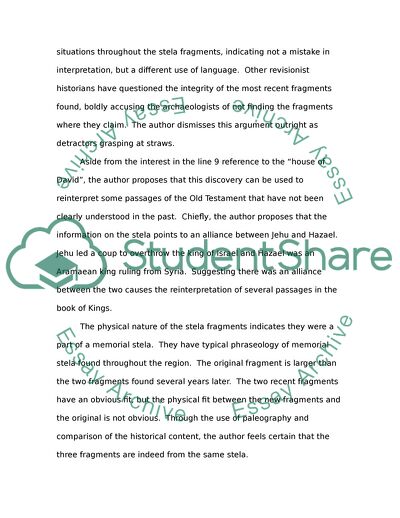
- Home
- Free Samples
- Premium Essays
- Editing Services
- Extra Tools
- Essay Writing Help
- About Us
- Studentshare
- Subjects
- Miscellaneous
- Schniedewind
Schniedewind - Essay Example

- Subject: Miscellaneous
- Type: Essay
- Level: Masters
- Pages: 4 (1000 words)
- Downloads: 0
- Author: nigeltrantow
Extract of sample "Schniedewind"
Part of the controversy arises because of the dating of the stela as being a product of the 9th century. This would seemingly be proof of King David’s rule as a monarch and the subsequent references to such in the Bible. The fact that the stela dates to the 9th century would indicate that the “house of David” was still a recognized political entity even though David’s reign is most commonly placed in the 10th century. Revisionist historians have long attacked the whole of the Bible as being fiction of late invention.
This is especially true for many accounts of the kings of Judah and Israel and the monarchs that preceded them. These historians have discounted the original stela fragments as not really referring to the “house of David” as the discoverers claim. The counterarguments against the interpretation of line 9 on the original fragment center on claims of a missing word divider. The author refutes this interpretation by showing that word dividers are missing in similar situations throughout the stela fragments, indicating not a mistake in interpretation, but a different use of language.
Other revisionist historians have questioned the integrity of the most recent fragments found, boldly accusing the archaeologists of not finding the fragments where they claim. The author dismisses this argument outright as detractors grasping at straws. Aside from the interest in the line 9 reference to the “house of David”, the author proposes that this discovery can be used to reinterpret some passages of the Old Testament that have not been clearly understood in the past. Chiefly, the author proposes that the information on the stela points to an alliance between Jehu and Hazael.
Jehu led a coup to overthrow the king of Israel and Hazael was an Aramaean king ruling from Syria. Suggesting there was an alliance between the two causes the reinterpretation of several passages in the book of Kings. The physical nature of the stela
...Download file to see next pages Read More
- TERMS & CONDITIONS
- PRIVACY POLICY
- COOKIES POLICY